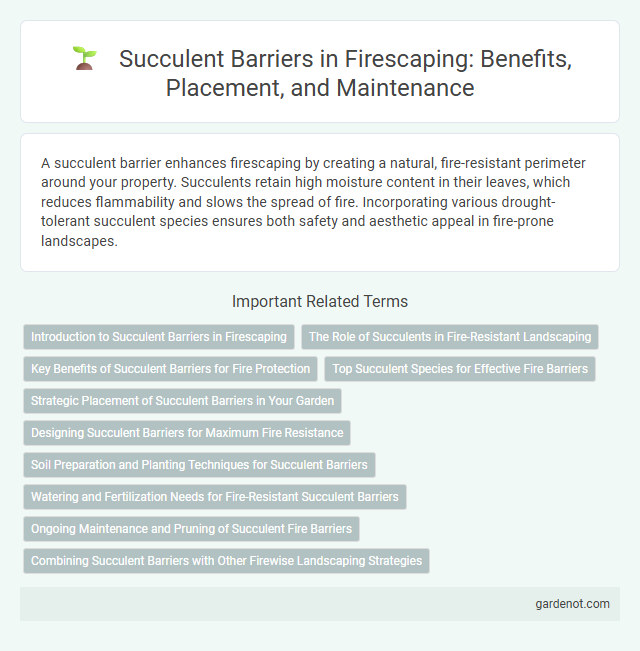A succulent barrier enhances firescaping by creating a natural, fire-resistant perimeter around your property. Succulents retain high moisture content in their leaves, which reduces flammability and slows the spread of fire. Incorporating various drought-tolerant succulent species ensures both safety and aesthetic appeal in fire-prone landscapes.
Introduction to Succulent Barriers in Firescaping
Succulent barriers serve as an effective firescaping element due to their high moisture content and low flammability, creating natural firebreaks that slow the spread of wildfires. These drought-tolerant plants, such as agave, aloe, and echeveria, thrive in fire-prone regions and require minimal irrigation, making them sustainable options for defensible space. Incorporating succulent barriers into landscape design enhances fire resistance while maintaining aesthetic appeal and ecological benefits.
The Role of Succulents in Fire-Resistant Landscaping
Succulents play a crucial role in fire-resistant landscaping due to their high water content and low flammability, making them effective natural fire barriers. Their thick, fleshy leaves retain moisture, reducing the likelihood of ignition and slowing fire spread when strategically planted around homes and property perimeters. Integrating succulent barriers in firescaping plans enhances safety by creating defensible spaces that limit fuel availability to wildfires.
Key Benefits of Succulent Barriers for Fire Protection
Succulent barriers provide an effective natural firebreak due to their high moisture content, which significantly reduces the likelihood of ignition and flame spread. Their dense, fleshy leaves retain water, helping to maintain a cooler microclimate around structures and landscapes during wildfire events. Incorporating succulent barriers into firescaping strategies enhances fire resilience while promoting water conservation and low maintenance.
Top Succulent Species for Effective Fire Barriers
A succulent barrier utilizes fire-resistant plants like Agave americana, Aloe arborescens, and Sedum spp. to create an effective natural firebreak due to their high water content and low flammability. Agave americana, known for its thick, spiky leaves, is highly effective in slowing fire spread, while Aloe arborescens provides dense, moisture-rich foliage that resists ignition. Sedum species thrive in various climates and form ground cover that reduces dry fuel accumulation, enhancing the overall fire mitigation strategy in firescaping designs.
Strategic Placement of Succulent Barriers in Your Garden
Strategic placement of succulent barriers in your garden enhances fire resistance by creating natural, moisture-rich zones that slow fire spread. Position succulents near vulnerable structures and along property lines to act as effective firebreaks due to their high water content and low flammability. Incorporating drought-tolerant succulents in key areas reduces fuel load while adding aesthetic and ecological value to the landscape.
Designing Succulent Barriers for Maximum Fire Resistance
Designing succulent barriers for maximum fire resistance involves selecting drought-tolerant succulent species with high moisture content that act as natural firebreaks. Planting dense clusters of fire-resistant succulents such as agave, aloe, and sedum creates a buffer zone that reduces flame intensity and slows fire spread around structures. Strategic placement along property perimeters and fuel-prone areas enhances landscape resilience, minimizing wildfire impact while maintaining aesthetic appeal.
Soil Preparation and Planting Techniques for Succulent Barriers
Soil preparation for succulent barriers requires well-draining, sandy or gritty soil mixed with organic matter to prevent water retention and root rot. Planting techniques involve spacing succulents adequately to allow airflow and utilizing shallow, wide holes to accommodate root systems while minimizing disturbance. Mulching with small gravel or stone further enhances drainage and helps maintain soil moisture, creating an effective fire-resistant barrier.
Watering and Fertilization Needs for Fire-Resistant Succulent Barriers
Succulent barriers require minimal watering, as these drought-tolerant plants store water in their thick leaves, reducing fire risk by maintaining high moisture content. Fertilization should be light and infrequent, using a balanced, low-nitrogen fertilizer to promote healthy growth without encouraging excessive, flammable foliage. Proper watering and fertilization practices help maintain the succulent barrier's fire-resistant properties and overall plant health.
Ongoing Maintenance and Pruning of Succulent Fire Barriers
Succulent fire barriers require ongoing maintenance to ensure their effectiveness in reducing wildfire risks by maintaining plant health and moisture content. Pruning is essential to remove dead or overgrown growth, promoting dense, low-fuel coverage that slows fire spread. Regular inspection and watering support the succulents' resilience, making these barriers a sustainable, fire-resistant landscape element.
Combining Succulent Barriers with Other Firewise Landscaping Strategies
Combining succulent barriers with other firewise landscaping strategies enhances overall fire protection by creating diverse, moisture-rich plant zones that slow fire spread effectively. Integrating succulents alongside fire-resistant trees, mulches, and strategic hardscaping reduces combustible fuel and increases landscape resiliency. This multi-layered approach significantly lowers wildfire risk and improves safety around homes and properties.
Succulent barrier Infographic

 gardenot.com
gardenot.com